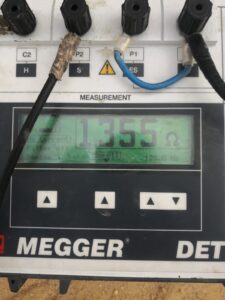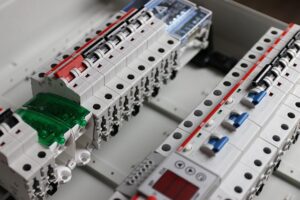Table of Contents
What is an electrical grounding system?
An electrical grounding system, or earthing system, is the process of connecting all metallic parts of electrical devices to the ground through an electrical low-resistance path, to provide safety for humans and devices.
An electrical grounding system is a critical component of electrical safety and system reliability. It provides a direct physical connection between electrical systems and the Earth, creating a reference point for electrical circuits. This system plays several roles:
-
Safety: It helps protect people from electrical shocks by providing a low-resistance path for fault currents to flow directly to the ground, reducing the risk of injury.
-
Protection of Equipment: Grounding prevents damage to electrical devices by stabilizing voltage levels and limiting transient overvoltages during events like lightning strikes or power surges.
-
Fault Current Return Path: It ensures a return path for fault currents, allowing protective devices like circuit breakers to operate correctly, thereby isolating faulty circuits.
-
Reduction of Electrical Noise: Grounding reduces electrical noise and interference in sensitive electronic equipment.
Connecting electrical equipment to the grounding provides an alternative path for fault current. The fact that electric current flows through the lower resistance path makes grounding electrical equipment a safety matter, in case of an electrical fault, the current will go through the grounding cable rather than going into a human body touching the faulty equipment.
For more information about Home and Workplace Electrical Safety, Read my article on my SAFETYFRENZY site.
the Working Principle of Electrical Grounding
An electrical grounding system serves as a low-resistance pathway for static charges and fault currents to safely dissipate into the earth.
In the event of an electrical fault, current naturally seeks the path of least resistance. By grounding electrical devices, we provide a safer alternative route for the current, preventing it from passing through the human body.
Electrons always flow along the shortest possible path within a circuit. If a fault occurs in the wiring, the grounding system ensures that excess current is diverted safely into the ground. This prevents potential hazards and safeguards both people and equipment.
The process involves connecting a copper conductor to a metal rod, which is then embedded deep into the ground. This setup is further linked to electrical panels, creating a reliable grounding network.
Whenever a fault arises, the grounding system directs the current through its low-resistance path, minimizing the risk of electrical shocks and equipment damage.
For grounding to be effective, the earthing resistance should be 5 ohms or less. This value depends on several factors, including soil resistivity, moisture levels, the number of grounding rods, and the size of the grounding cables.
Why is electrical grounding important?
Electrical grounding is vital for several reasons, primarily related to safety, system functionality, and equipment protection:
-
Safety of People: Grounding helps protect individuals from electrical shocks by providing a low-resistance path for fault currents, directing them safely into the ground. This reduces the likelihood of injury during electrical faults or equipment malfunctions.
-
Equipment Protection: Proper grounding stabilizes voltage levels in the electrical system, preventing damage to devices due to power surges, transient overvoltages, or lightning strikes.
-
Fault Detection and Isolation: Grounding provides a return path for fault currents, enabling protective devices like circuit breakers and fuses to operate effectively. This helps isolate faulty sections and prevents further damage.
-
Prevention of Electrical Noise: Grounding reduces electrical noise and interference in sensitive systems, ensuring stable and accurate operation of electronic equipment.
-
Fire Prevention: By preventing the buildup of stray currents, grounding reduces the risk of electrical fires caused by sparks or overheating.
-
System Reliability: Grounding enhances overall system stability by providing a reference point for voltages, ensuring consistent performance in both normal and fault conditions
Grounding system inspection
Over time, ground rods are degraded due to soil moisture, salt, and temperature. This means that the grounding resistance becomes larger than 5 Ohms and the system is not effective for its purpose.
For all the above it’s important to make periodic maintenance and check the system of earthing.
To do so measure grounding resistance and record its value every three years and visually check and inspect grounding cables and connections for any corrosion and damage.
How to measure grounding resistance?

It’s an easy job to measure the resistance value of a grounding system using a clamp meter like Fluke 1630-2 FC Earth Ground Clamp, it needs no special training to use it.
The Megger earthing meter is another way to measure grounding resistance. The device has three cables, one to connect with the earthing rod and two others connected to testing rods, 50cm copper rods.
We dig the testing rods to about 40cm depth, connect them with the device, and connect the other cable to the earthing rod to measure its resistance. Turn on the device and you’re done.
What Devices Require a Grounding System?
All metallic parts of electrical equipment, including electrical transformers, motors, and generators must be grounded through low-resistance cables connected to the earthing system.
Grounding is essential for safety, especially in cases where the insulation of electrical equipment fails. When this happens, dangerous voltages can build up on the metallic parts of the equipment.
Without proper grounding, these voltages have no safe path to discharge and may transfer to anyone who touches the equipment, leading to serious electric shocks. Grounding ensures that these voltages are safely diverted into the earth, protecting both people and equipment from harm.
Should I ground my house?
Yes, grounding your house is essential for safety and the proper functioning of your electrical system. Here’s why:
-
Protection from Electric Shocks
Grounding provides a safe pathway for fault currents to flow into the earth, preventing them from passing through your body if you touch a faulty appliance or exposed wiring. -
Prevention of Electrical Fires
Fault currents or power surges can cause excessive heat, potentially leading to electrical fires. Grounding helps safely dissipate these surges, reducing the risk of fire. -
Protection of Electrical Devices
Grounding shields your appliances and devices from damage caused by voltage spikes or lightning strikes, extending their lifespan. -
Compliance with Electrical Codes
Most building codes and electrical standards require homes to have a grounding system to ensure safety. -
Improved System Performance
Grounding enhances the overall stability of your electrical system by reducing voltage fluctuations and interference.
If your house isn’t grounded, you should consult a licensed electrician to assess and install a proper grounding system. This investment ensures the safety of your household and protects your property from potential electrical hazards.
How much should a grounding resistance be?
The grounding (or earthing) resistance is a crucial factor in ensuring the safety and effectiveness of an electrical system. Here’s what you need to know:
-
Recommended Grounding Resistance
- For most residential and commercial installations, the grounding resistance should be 5 ohms or less.
- In some cases, especially for sensitive equipment like in data centers or hospitals, the target can be as low as 1 ohm.
-
Why Low Resistance is Important
A low grounding resistance ensures that fault currents and transient voltages are safely and quickly diverted into the ground, minimizing the risk of electric shock, equipment damage, and fire. -
Factors Affecting Grounding Resistance
- Soil Resistivity: Different types of soil conduct electricity differently. Wet or clay-rich soil typically has lower resistance than dry or sandy soil.
- Moisture Levels: Higher soil moisture reduces resistance.
- Temperature: Cold or frozen ground can increase resistance.
- Number and Depth of Grounding Rods: More rods and deeper placement lower resistance.
- Conductor Size and Material: Larger cables and materials with high conductivity, like copper, improve grounding performance.
-
Testing and Maintenance
Regular testing of the grounding system is essential to ensure resistance remains within acceptable limits, especially in changing environmental conditions.
If your grounding resistance is higher than recommended, consult a qualified electrician to improve the system by adding more grounding rods, using conductive back fill, or other methods.
How Does Grounding Prevent An Electric Shock?
Grounding plays a crucial role in protecting people from electric shocks by providing a safe path for electrical current to flow. Here’s how it works:
-
Creates a Low-Resistance Path to the Ground
In the event of a fault, such as a damaged wire or insulation failure, the electrical current may leak and energize the metal parts of appliances or other equipment. Grounding connects these parts to the earth through a low-resistance path, allowing the fault current to flow safely into the ground instead of through a person who touches the equipment. -
Reduces the Risk of Contact Voltage
Without grounding, metal parts could carry dangerous voltages. If someone touches these energized parts, the current would flow through their body to the ground, potentially causing severe injury or even death. Grounding ensures that any stray voltage is directed away from people. -
Enables Circuit Protection Devices to Operate
Grounding works in conjunction with devices like circuit breakers and fuses. When a fault occurs, the flow of fault current to the ground creates a sudden increase in current. This triggers the breaker or fuse to trip, cutting off power to the faulty circuit and preventing further risk of shock or fire. -
Protection During Lightning Strikes or Power Surges
Grounding also helps in safely dissipating high-energy surges from lightning strikes or power line issues, preventing them from harming people or damaging appliances.
Grounding acts as a critical safety mechanism, ensuring that fault currents are redirected away from people and sensitive equipment, thereby preventing electric shocks and enhancing the safety of your electrical system.
Can Any Wire Be Used As a Ground Wire?
No, not all wires are suitable for use as a ground wire. Here are the key factors that determine what makes a wire appropriate for grounding:
Material
- Copper: The most common and preferred material for ground wires due to its excellent conductivity and durability.
- Aluminum: Sometimes used but less common because it has lower conductivity compared to copper and can be prone to corrosion.
- Steel: Used in specific industrial applications but generally not ideal for residential grounding due to higher resistance.
Wire Size (Gauge)
The wire must be thick enough to handle potential fault currents safely. The required gauge depends on the electrical system and local code requirements. Common sizes for ground wires in residential applications are #6 AWG to #10 AWG, but industrial systems may require larger wires.
Insulation
Ground wires may be bare (uninsulated) or insulated, depending on the application:
- Bare Wire: Often used in grounding systems since the insulation is unnecessary for the ground path.
- Insulated Wire: Used when the ground wire runs through conduits or other enclosed spaces to prevent accidental contact with other conductive materials.
Code Compliance
Ground wires must meet local and international electrical codes (e.g., NEC, IEC) to ensure safety and effectiveness. Always check with a licensed electrician to ensure compliance.
Purpose-Built Grounding Wires
It’s best to use wires specifically designed for grounding, as these are manufactured to meet the necessary safety standards and perform reliably in fault conditions.
Conclusion
Not any wire can be used as a ground wire. It must be made from the right material, be of sufficient size, and meet safety and code requirements to ensure effective protection against electrical hazards. Always consult a professional when selecting grounding wires for your electrical system.
For more information about electrical conductors, you can check out my detailed article.
Can I use Aluminum Wire for Grounding?
Yes, aluminum wire can be used for grounding in certain situations, but there are important considerations to keep in mind:
Electrical Conductivity
- Lower Conductivity than Copper: Aluminum has about 60% of the conductivity of copper, which means it requires a larger wire size to carry the same amount of current.
- However, for grounding purposes, aluminum can still provide an adequate path for fault currents if sized correctly.
Corrosion Concerns
- Oxidation: Aluminum forms an oxide layer when exposed to air, which can increase resistance over time.
- Moisture and Galvanic Corrosion: In environments with high humidity or where aluminum contacts other metals (e.g., copper), corrosion can occur, reducing effectiveness.
To mitigate this:
- Use anti-oxidant compounds at connections.
- Ensure proper insulation or coating.
Code Compliance
- Aluminum grounding wire must meet local and international electrical codes. In the National Electrical Code (NEC), aluminum is permitted for grounding in specific applications, but the installation must follow strict guidelines.
- Some regions or applications, such as certain industrial setups, may restrict or discourage the use of aluminum for grounding due to the risks mentioned above.
Applications Where Aluminum Grounding May Be Suitable
- Large-Scale Installations: Aluminum is commonly used in industrial and utility-scale grounding systems, especially for cost savings in long runs.
- Grounding of Transformer Neutrals or Substations: These setups often use aluminum because of its lighter weight and lower cost compared to copper.
Maintenance and Inspections
Aluminum grounding systems may require more frequent inspections and maintenance to ensure they remain effective over time, especially in harsh environments.
Conclusion
While aluminum wire can be used for grounding, it must be carefully selected, properly installed, and regularly maintained to ensure safety and reliability. For residential systems, copper is often preferred due to its higher conductivity and durability, but aluminum can be a cost-effective option for larger-scale or specific applications. Always consult a licensed electrician and ensure compliance with local codes.
Consulting with a qualified electrician or electrical engineer is recommended to ensure compliance with all applicable standards and safety guidelines.
Don’t Leave Empty-Handed!
Install my Free Android App on Google Play:
Electrical Cables Most Common Tables “Cables Tables”
And, my Electrical Calculations App “Fast Electrical Calculator”
Discover more great content by subscribing to My channel
Looking to stay ahead of the game in the world of electrical engineering? Subscribe to my YouTube channel and gain access to exclusive content you won’t find anywhere else!
The staff I recommend
(Amazon Affiliate Links to products I believe are high quality):
- Economy 120 Volt/60Hz AC Power Source – Step-Down Voltage & Frequency Converters 1800W
- UNI-T Digital Multimeter Tester UT139C
- 50-Amp Extension Cord for RV “100ft”
- Voltage Stabilizer 110/220v
- Hair Dryer “best selling“
- TOSHIBA EM131A5C-BS Countertop Microwave Ovens
Disclaimer: This contains affiliate links to Amazon products. I may earn a commission for purchases made through these links.



